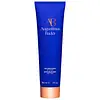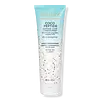What's inside
What's inside
 Key Ingredients
Key Ingredients

 Benefits
Benefits

 Concerns
Concerns

 Ingredients Side-by-side
Ingredients Side-by-side

Water
Skin ConditioningDistearoylethyl Dimonium Chloride
Cetearyl Alcohol
EmollientGlycerin
HumectantErythritol
HumectantPanthenol
Skin ConditioningCetyl Alcohol
EmollientRicinus Communis Seed Oil
MaskingSaccharide Isomerate
HumectantPotassium Sorbate
PreservativeCitric Acid
BufferingCocos Nucifera Oil
MaskingHydrolyzed Vegetable Protein
Skin ConditioningAvena Sativa Kernel Oil
Skin ConditioningPunica Granatum Seed Oil
EmollientSodium Benzoate
MaskingSodium Phytate
Maltodextrin
AbsorbentHydrolyzed Rice Protein
Skin ConditioningSodium Hydroxide
BufferingLepidium Meyenii Root Extract
Skin ConditioningNasturtium Officinale Extract
PerfumingTropaeolum Majus Extract
AntimicrobialCamellia Sinensis Leaf Extract
AntimicrobialHydrogenated Lecithin
EmulsifyingTocopheryl Acetate
AntioxidantXanthan Gum
EmulsifyingSodium Citrate
BufferingTocopherol
AntioxidantSorbic Acid
PreservativeAlanyl Glutamine
HumectantArginine
MaskingOligopeptide-177
Sodium Chloride
MaskingPhenylalanine
MaskingSisymbrium Irio Seed Oil
MaskingWater, Distearoylethyl Dimonium Chloride, Cetearyl Alcohol, Glycerin, Erythritol, Panthenol, Cetyl Alcohol, Ricinus Communis Seed Oil, Saccharide Isomerate, Potassium Sorbate, Citric Acid, Cocos Nucifera Oil, Hydrolyzed Vegetable Protein, Avena Sativa Kernel Oil, Punica Granatum Seed Oil, Sodium Benzoate, Sodium Phytate, Maltodextrin, Hydrolyzed Rice Protein, Sodium Hydroxide, Lepidium Meyenii Root Extract, Nasturtium Officinale Extract, Tropaeolum Majus Extract, Camellia Sinensis Leaf Extract, Hydrogenated Lecithin, Tocopheryl Acetate, Xanthan Gum, Sodium Citrate, Tocopherol, Sorbic Acid, Alanyl Glutamine, Arginine, Oligopeptide-177, Sodium Chloride, Phenylalanine, Sisymbrium Irio Seed Oil
Water
Skin ConditioningAloe Barbadensis Leaf Juice
Skin ConditioningCetyl Alcohol
EmollientStearyl Alcohol
EmollientPPG-3 Benzyl Ether Myristate
EmollientCetrimonium Chloride
AntimicrobialPrunus Armeniaca Kernel Oil
MaskingLens Esculenta Seed Extract
Skin ProtectingHydrolyzed Cicer Seed Extract
Skin ProtectingChenopodium Quinoa Seed Extract
Skin ConditioningDiheptyl Succinate
EmollientCapryloyl Glycerin/Sebacic Acid Copolymer
Skin ConditioningHydrogenated Castor Oil/Sebacic Acid Copolymer
EmollientStearamidopropyl Dimethylamine
EmulsifyingBehentrimonium Methosulfate
Cetearyl Alcohol
EmollientSr-Hydrozoan Polypeptide-1
HumectantCopper Tripeptide-1
Skin ConditioningCaffeine
Skin ConditioningBiotin
AntiseborrhoeicCocos Nucifera Water
MaskingGlycerin
HumectantCocos Nucifera Fruit Juice
EmollientPanax Ginseng Root Extract
EmollientCocos Nucifera Oil
MaskingAmaranthus Caudatus Seed Extract
Skin ConditioningCaramel
Cosmetic ColorantParfum
MaskingTocopherol
AntioxidantPanthenol
Skin ConditioningCitric Acid
BufferingPotassium Sorbate
PreservativeSodium Benzoate
MaskingEthylhexylglycerin
Skin ConditioningWater, Aloe Barbadensis Leaf Juice, Cetyl Alcohol, Stearyl Alcohol, PPG-3 Benzyl Ether Myristate, Cetrimonium Chloride, Prunus Armeniaca Kernel Oil, Lens Esculenta Seed Extract, Hydrolyzed Cicer Seed Extract, Chenopodium Quinoa Seed Extract, Diheptyl Succinate, Capryloyl Glycerin/Sebacic Acid Copolymer, Hydrogenated Castor Oil/Sebacic Acid Copolymer, Stearamidopropyl Dimethylamine, Behentrimonium Methosulfate, Cetearyl Alcohol, Sr-Hydrozoan Polypeptide-1, Copper Tripeptide-1, Caffeine, Biotin, Cocos Nucifera Water, Glycerin, Cocos Nucifera Fruit Juice, Panax Ginseng Root Extract, Cocos Nucifera Oil, Amaranthus Caudatus Seed Extract, Caramel, Parfum, Tocopherol, Panthenol, Citric Acid, Potassium Sorbate, Sodium Benzoate, Ethylhexylglycerin
Ingredients Explained
These ingredients are found in both products.
Ingredients higher up in an ingredient list are typically present in a larger amount.
Cetearyl alcohol is a mixture of two fatty alcohols: cetyl alcohol and stearyl alcohol. It is mainly used as an emulsifier. Emulsifiers help prevent the separation of oils and products. Due to its composition, it can also be used to thicken a product or help create foam.
Cetearyl alcohol is an emollient. Emollients help soothe and hydrate the skin by trapping moisture.
Studies show Cetearyl alcohol is non-toxic and non-irritating. The FDA allows products labeled "alcohol-free" to have fatty alcohols.
This ingredient is usually derived from plant oils such as palm, vegetable, or coconut oils. There is debate on whether this ingredient will cause acne.
Due to the fatty acid base, this ingredient may not be Malassezia folliculitis safe.
Learn more about Cetearyl AlcoholCetyl Alcohol is a fatty alcohol. Fatty Alcohols are most often used as an emollient or to thicken a product.
Its main roles are:
Though it has "alcohol" in the name, it is not related to denatured alcohol or ethyl alcohol.
The FDA allows products labeled "alcohol-free" to have fatty alcohols.
Learn more about Cetyl AlcoholCitric Acid is an alpha hydroxy acid (AHA) naturally found in citrus fruits like oranges, lemons, and limes.
Like other AHAs, citric acid can exfoliate skin by breaking down the bonds that hold dead skin cells together. This helps reveal smoother and brighter skin underneath.
However, this exfoliating effect only happens at high concentrations (20%) which can be hard to find in cosmetic products.
Due to this, citric acid is usually included in small amounts as a pH adjuster. This helps keep products slightly more acidic and compatible with skin's natural pH.
In skincare formulas, citric acid can:
While it can provide some skin benefits, research shows lactic acid and glycolic acid are generally more effective and less irritating exfoliants.
Most citric acid used in skincare today is made by fermenting sugars (usually from molasses). This synthetic version is identical to the natural citrus form but easier to stabilize and use in formulations.
Read more about some other popular AHA's here:
Learn more about Citric AcidCocos Nucifera Oil is obtained from the kernels of the coconut fruit. In other words, this is coconut oil.
Coconut Oil is rich in fatty acids with lauric acid making up the majority of these. It also contains linoleic acid. Due to this high fatty acid content, coconut oil helps trap moisture and soften skin.
Despite being antibacterial, coconut oil may not be great for acne-prone skin. It is comedogenic and may clog pores. This ingredient may not be safe for malassezia or fungal acne.
Note: Coconut Oil should not replace your sunscreen for UV protection. Studies show it only blocks about 20% of UV.
This oil is non-volatile and has a light scent.
The term 'fragrance' is not regulated in many countries. In many cases, it is up to the brand to define this term. For instance, many brands choose to label themselves as "fragrance-free" because they are not using synthetic fragrances. However, their products may still contain ingredients such as essential oils that are considered a fragrance.
Learn more about Cocos Nucifera OilGlycerin is already naturally found in your skin. It helps moisturize and protect your skin.
A study from 2016 found glycerin to be more effective as a humectant than AHAs and hyaluronic acid.
As a humectant, it helps the skin stay hydrated by pulling moisture to your skin. The low molecular weight of glycerin allows it to pull moisture into the deeper layers of your skin.
Hydrated skin improves your skin barrier; Your skin barrier helps protect against irritants and bacteria.
Glycerin has also been found to have antimicrobial and antiviral properties. Due to these properties, glycerin is often used in wound and burn treatments.
In cosmetics, glycerin is usually derived from plants such as soybean or palm. However, it can also be sourced from animals, such as tallow or animal fat.
This ingredient is organic, colorless, odorless, and non-toxic.
Glycerin is the name for this ingredient in American English. British English uses Glycerol/Glycerine.
Learn more about GlycerinPanthenol is a common ingredient that helps hydrate and soothe the skin. It is found naturally in our skin and hair.
There are two forms of panthenol: D and L.
D-panthenol is also known as dexpanthenol. Most cosmetics use dexpanthenol or a mixture of D and L-panthenol.
Panthenol is famous due to its ability to go deeper into the skin's layers. Using this ingredient has numerous pros (and no cons):
Like hyaluronic acid, panthenol is a humectant. Humectants are able to bind and hold large amounts of water to keep skin hydrated.
This ingredient works well for wound healing. It works by increasing tissue in the wound and helps close open wounds.
Once oxidized, panthenol converts to pantothenic acid. Panthothenic acid is found in all living cells.
This ingredient is also referred to as pro-vitamin B5.
Learn more about PanthenolPotassium Sorbate is a preservative used to prevent yeast and mold in products. It is commonly found in both cosmetic and food products.
This ingredient comes from potassium salt derived from sorbic acid. Sorbic acid is a natural antibiotic and effective against fungus.
Both potassium sorbate and sorbic acid can be found in baked goods, cheeses, dried meats, dried fruit, ice cream, pickles, wine, yogurt, and more.
You'll often find this ingredient used with other preservatives.
Learn more about Potassium SorbateSodium Benzoate is a preservative. It's used in both cosmetic and food products to inhibit the growth of mold and bacteria. It is typically produced synthetically.
Both the US FDA and EU Health Committee have approved the use of sodium benzoate. In the US, levels of 0.1% (of the total product) are allowed.
Sodium benzoate works as a preservative by inhibiting the growth of bacteria inside of cells. It prevents the cell from fermenting a type of sugar using an enzyme called phosphofructokinase.
It is the salt of benzoic acid. Foods containing sodium benzoate include soda, salad dressings, condiments, fruit juices, wines, and snack foods.
Studies for using ascorbic acid and sodium benzoate in cosmetics are lacking, especially in skincare routines with multiple steps.
We always recommend speaking with a professional, such as a dermatologist, if you have any concerns.
Learn more about Sodium BenzoateTocopherol (also known as Vitamin E) is a common antioxidant used to help protect the skin from free-radicals and strengthen the skin barrier. It's also fat soluble - this means our skin is great at absorbing it.
Vitamin E also helps keep your natural skin lipids healthy. Your lipid skin barrier naturally consists of lipids, ceramides, and fatty acids. Vitamin E offers extra protection for your skin’s lipid barrier, keeping your skin healthy and nourished.
Another benefit is a bit of UV protection. Vitamin E helps reduce the damage caused by UVB rays. (It should not replace your sunscreen). Combining it with Vitamin C can decrease sunburned cells and hyperpigmentation after UV exposure.
You might have noticed Vitamin E + C often paired together. This is because it is great at stabilizing Vitamin C. Using the two together helps increase the effectiveness of both ingredients.
There are often claims that Vitamin E can reduce/prevent scarring, but these claims haven't been confirmed by scientific research.
Learn more about TocopherolWater. It's the most common cosmetic ingredient of all. You'll usually see it at the top of ingredient lists, meaning that it makes up the largest part of the product.
So why is it so popular? Water most often acts as a solvent - this means that it helps dissolve other ingredients into the formulation.
You'll also recognize water as that liquid we all need to stay alive. If you see this, drink a glass of water. Stay hydrated!
Learn more about Water